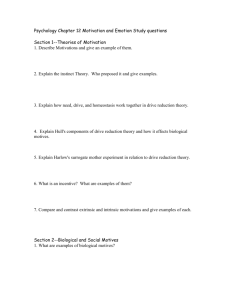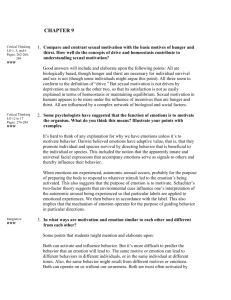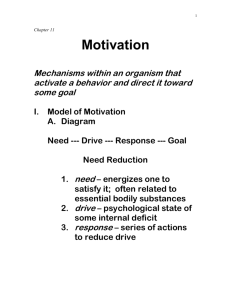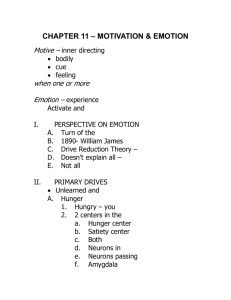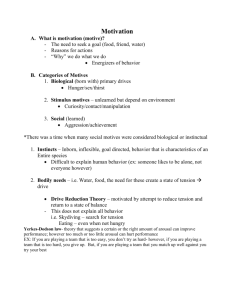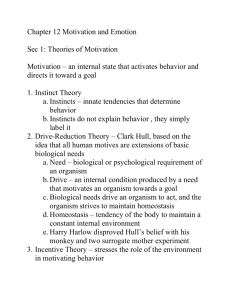Motivation and Emotion - Point Loma High School
advertisement
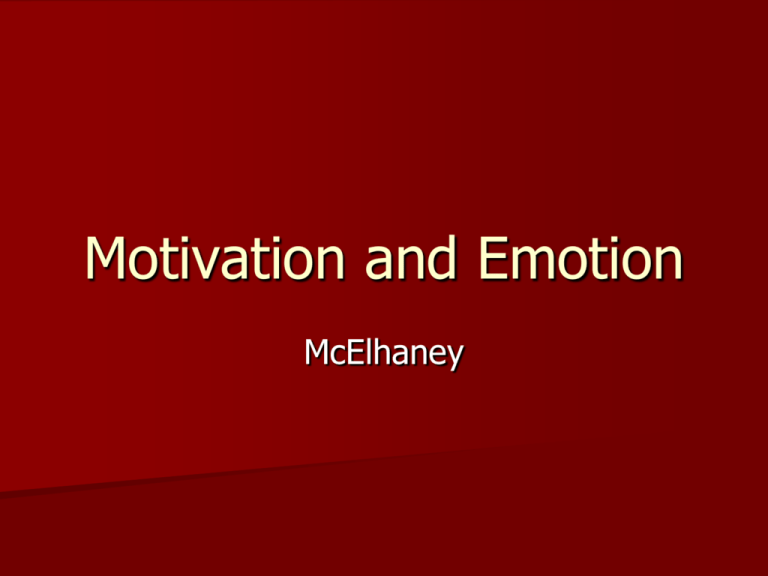
Motivation and Emotion McElhaney AP Outline VIII. Motivation and Emotion (7–9%) Biological Bases Theories of Motivation – Instinct, Drive Reduction, Optimal Arousal, Incentive Theories Hunger- Eating Disorders; Thirst, Sex, Social Cultural Factors, Sexual Orientation and Pain Social Motives, Achievement Motivation, Theories of Emotion, James-Lange Theory, CannonCognitive Theory; Characteristics, Biology of Emotion, Emotional Expressions Stress Basics of Motivation There are links between motives and emotions Basic motives- Hunger-thirst are monitored within the brain Activities/motives are related to needs for stimulation and to maintain arousal Definition of Motivation: The factors that influence initiation, direction, intensity + persistence of behavior Why do we do what we do? – Behavior is based partly on the desire to feel certain emotions. How is motivation exemplified by Hunger, sexual desire and Need for Achievement? Motivation effects emotion example- hunger and irritibility Motive: A reason or purpose that provides a single explanation for diverse behaviors. Some psychologists think of motivation as an “intervening variable” Intervening variable is something that is used to explain the relationship between environmental stimuli and behavioral responses. 4 Categories of Motivation 1. 2. 3. 4. Biological Factors- Autonomic Nervous System Emotional Factors- panic, fear, anger, love, hatred Cognitive Factors- perceptions, beliefs, expectations Social Factors – other people, influence from parents, friends, teachers, TV, Siblings…Factors- Theories of Motivation (web) Instinct- (see one page overview) Drive Reduction- Optimal Arousal- Incentive- Basic Model of Motivation Dynamics of behavior in the way actions are: – Initiated – Sustained – Directed – Terminated Example of Food Seeking Initiated by bodily need Search was sustained Action directed by possible sources Terminated by attained goal The Model (Motives) Motivational Activities- begin with needs – Need is an internal deficiency Needs cause - Drive= energized state that facilitates a need Drives --activate a response = an action or series of actions to attain a goal Goals are targets of motivational behavior Need Drive Need reduction Goal response Difference between Needs and Drives Needs – are stronger than drives Drives fluctuate in strength External Stimuli Motivated behavior can be energized by the pull of External Stimuli And push of internal needs Action is a Mix Internal needs and External Incentives (types of conflicts are associated) Incentive value of goals helps us understand motives that don’t come from internal needs – Example success = status-approval Types of Motives: 3 Categories Primary-(innate) Based on biological needs Must be met for survival Hunger, thirst, pain avoidance Air, sleep Elimination of waste 2. Stimulus Motives (not necessarily for survival) Need for stimulation Need for information Activity Curiosity Exploration Manipulation Physical contact Motive 2- Stimulus Not necessary for survival Stimulus Drives= reflect need for: Need for stimulation Need for information Activity – curiosity Exploration- manipulation Physical contact Sensory input 3. Secondary Motives (learned motives) Learned needs or drives and goals Making music Competing Learned needs for power – – – – – – For affiliation Status Security Approval Achievement Fear + Aggression are learned Arousal Theory Says ideal levels of activation exist for various activities Arousal refers to activation of body + nervous system – – – – Zero@death.com = no arousal=death Low during sleep or boredom Moderate during daily activities High at times of excitement, emotion, panic, fear and anxiety Levels of Arousal We perform best when we have a Moderate level of Arousal Not too passive/not too anxious=Performance Inverted U Function Says at low levels of arousal=decrease performance More arousal= improved performance Levels of Arousal 2 Ideal level arousal depends on complexity of the task Simple tasks--Best for arousal to be high Complex tasks best for low/moderate arousal Yerkes-Dodson Law Sensation Seekers People learn to seek particular levels of arousal Sensation seeking scale+ Thrill +adventure seeking – Experience seeking – Disinhibition – Boredom Susceptibility Motive 3Secondary Motives Learned motives Learned needs or drives and goals Making music…Competing Learned need for – – – – – – – Power Affiliation Status Security Approval Achievement Fear + aggression are learned Primary Motive is Homeostasis Biological needs- direct much of our behavior Are used to maintain body balance= Homeostasis Hunger (motive) is a regular cycle each day Good example of how internal and external factors direct behavior Liver affects hunger Hunger 2 Stomach size some indication of hunger Glucose- level in blood and hypoglycemia = low blood sugar level Feeling of hunger causes stomach contractions Liver sends nerves signal to brain desire to eat Primary Motives Continued Thirst, Sex, and pain avoidance Thirst 2 kinds Extra-cellular thirst- when water is lost from fluids surrounding cells – Bleeding, vomiting, sweating, drinking alcohol Intra-cellular thirst – Salt level – Draws fluid out of cells PainDrive to avoid pain=episodic Takes place at certain episodes when body is or is about to be damaged Prompts us to avoid pain Pain tolerance- is learned- raise of lower tolerance Brian Mechanisms There are many parts of brain associated with motivation Hypothalamus does regulate motivation and emotion – Thirst, hunger, sexual behavior – Is sensitive to sugar in the blood – Receives neural messages from liver and stomach – One part signals hunger =feeding system Which initiates eating Hypothalamus 2 Lateral hypothalamus- (hunger feelings) – When electrified causes animals to eat – If destroyed = no eating Ventro-Medial Hypothalamus Part of Hypothalamus relates directly to Satiety (fullness) feelings= stop mechanism If destroyed = overeating (Bottom medium part of the hypothalamus) Marijuana-”Mary-Jane” causes a hypothalamic response= “Munchies” Paraventricular Nucleus of Hypothalamus Affects hunger= helps keep blood sugar level steady Both- starts and stops eating Sensitive to Neuropeptide Y (NPY) – Large amount = hunger Glucagon -Like Peptide 1 (GLP1) Causes eating to cease – Released by intestines – After eating a meal – In blood then to brain – 10 minutes after eating- (eat slow = eat less) Set Point- Thermostat When fat levels rise Leptin- Fat cells release-tells brain to stop eating. The body is homeostatic when we are at the set point and then it is activated to reach the set point when we fall below. Taste Aversion Associated with nausea – Classical conditioning – Biological tendency- associate food with sickness – Protective Eating Disorders Anorexia Nervosa – Adolescent Females <5-10% male> – Severe Dieting – Compulsive attempt to lose weight – Do not seek or desire food – 1 in 20 die of malnutrition Bulimia Nervosa – Gorge on food then vomit – Take laxatives to avoid weight gain Causes of Bulimia Anorexia Women dissatisfied with bodies – Distorted view of themselves – “They think they’re fat, exaggerated fears of becoming fat.” Distorted Messages from media – Compulsion- comparing to models – Distorted body image Perfect daughter control issues Shame, guilt, self contempt, anxiety Treatment of Eating Disorders Medical diet Behavioral Counseling- self monitoring of food intake – Extinction training (to end the learned behavior) urge to vomit Cognitive approach– Change the thinking patterns & belief system about weight + body image Usually people need outside support and urging from family Sex Drive Sex Drive= one’s motivation to engage in sexual behavior Mammals- femalehormone- Estrus = “Heat” Caused by Estrogen Male animals Ready to mate sex drive= aroused by behavior + sent of receptive female Human Sex Drive Non-Homeostatic- it works independent of bodily need Sex drive in men is related to amount of Androgens= male hormone Produced by testes (puberty- increases supply of androgens) Women Sex Drive Produce Androgens causes increase in sex drive Human Sex Drive Human sex Drive can be aroused at anytime Sexual activity- does not prevent sexual desire Sex drive can be aroused + Reduced “The Coolidge Effect” – Male sex drive can be aroused repeatedly with new sexual partners. – Circadian Rhythms Internal Biological Clocks – 24 hour cycle – Guide Body Activity Liver Kidney Blood Pressure Endocrine Glands Peak During Day Adrenaline is 3-5x higher Test Anxiety Pg 445 Learned Motives We learn to pursue excellence Reinforcers– Praise money, success--affect goals and desires Opponent Process Theory Richard Solomon (1980) Explains learned motives Example drug addiction “If a stimulus causes a strong emotion <Fear or Pleasure> an opposite emotion tends to occur when stimulus ends” Stimulus of pain + Pain ends =relief Opponent Process Theory 2 Pleasure + Drug use – end of drug use= Pleasure ends – craving & discomfort develops In love + feel good when lover is present Take away lover = discomfort when they are not there If stimulus is repeated- our response is habituated (gets weaker) Emotional after affects get stronger with repetition (example- depression when drug use ends) Social Motives Success, money, possessions, status, love, approval, grades, power Acquired through conditioning + socialization Due to learned needs Need For Achievement (nAch) A desire to meet an internal standard of excellence People strive to do well- in any situation which evaluation takes place People for high need for achievement enjoy challenges + chances to test abilities Need For Achievement (NACH) Mclelland- could predict behavior of high and low achievers. Characteristics of: – People with high (nAch) don’t seek goals that are too easy – Avoid goals that are too risky – Complete difficult tasks to get grades – Excel in occupations – Work harder when they don’t do well Achievers- Key To Success Benjamin Bloom Identified via a study Found drive and determination = success Achievers- Parents Support Success in Children Parents expose children to music, swimming, science, (ideas for fun) (Stimulating environment= more synapses) Talent is nurtured by dedication + hard work Support child’s special interest Emphasize doing one’s best at all times Coaching and encouraging practice Achievers- Self Confidence= people believe they can reach a goal Set goals that are specific and challenging but attainable Visualize the steps you need to reach your goal Advance with small steps Get expert instruction Find skilled models to emulate Get support + encouragement If you fail- regard it as a sign you need to try harder Self Confidence affects Motivation--- “Duh” Abraham Maslow Described a Hierarchy of Human needs Self actualizing = Full use of personal potential Base of Pyramid= Necessary for survival Pre-potent = Dominant over higher needs Deficiency MotivesActivated by a lack of – food, water, security, love, esteem, or other basic need. Growth needs– Positive- life enhancing for personal growth. Meta needs Higher needs, Tendency for self-actualization Meta Needs We tend to move up to Meta needs A person who meets survival needs then moves to meta needs if these are unfulfilled They are in a “ Syndrome of Decay” Characterized by despair, apathy, and Alienation Syndrome of decay- when we cannot reach our higher other needs Most people are concerned with esteem, love, security, but they don’t get much past that. Intrinsic and Extrinsic Motives Intrinsic motivation- we act without any obvious external rewards. You are motivated on your own part.= high achievers Extrinsic- external rewards enhance motivation- ex money, grades, approval Creativity + Motivation Creativity is enhanced by personal interest and freedom of choice. Killed when you are limited (surveillance, rules, conforming) Working to get money= not being creative Children and intrinsic motivation If basic skill is lacking, extrinsic activity can help develop intrinsic motivation. Basics of Emotion Emotions help us to adapt to environment = physiological arousal Emotional Knowledge= self awareness Empathy Can manage feelings We can use emotions Romantic love is in this chapter Emotions Help and can cause problems- hate, anger, fear Disrupts behavior and damages relationships Physiological- bodily responses Posture, tone, facial expressions, body language= emotional outward expressions Sympathetic nervous system ANS= responses to emotion. Sympathetic= activates emotion, arousal, fight or flight Parasympathetic- opposite. Slows down the reaction and conserves energy. Plutchik Plutchik’s 8 primary emotions: Fear, surprise, sadness, disgust, anger, anticipation, joy, and trust/ acceptance They fluctuate in intensity and can be mixed and yield to another emotion (hybrid emotion) Moods are tied to circadian rhythms. Brain and Emotion Positive emotion= left hemisphere. Negative emotion= right hemisphere. Some emotional processing= cerebral cortex Amygdala= fear Facial Expressions Expressing Emotions “Psychologists believe that emotional expressions evolved to communicate our feelings to others which aids survival” People more sensitive to angry, scheming thinking, faces… Basic Facial expressions seem to be universal Cultural Differences in Emotion Asian cultures- group harmony is important - Anger is not a public emotion America and Western Europe= Anger is common reflects values of independence + rights justice

